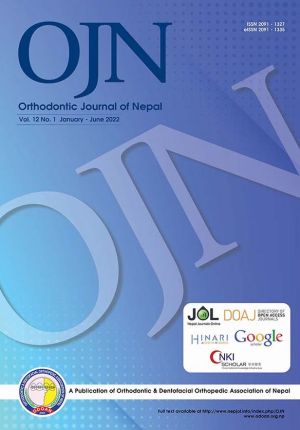Applicability of Pulp Tooth Area Ratio in Age Estimation using Mandibular Premolars
DOI:
https://doi.org/10.3126/ojn.v12i1.47482Keywords:
Age, orthopantomograms, pulp/tooth areaAbstract
Introduction: Age estimation is an important parameter in forensic for identification of individuals. Cameriere developed pulp tooth area ratio as age estimation method in Orthopantomogram. Objective of this study was to use Pulp tooth area ratio of mandibular premolars and derive population-specific equations for age estimation.
Materials and Method: A retrospective study was conducted in Department of Oral and Maxillofacial Pathology, Kantipur Dental College and Teaching Hospital from June 2021 to November 2021 after ethical clearance no 10/021. Total 392, Orthopantomograms of patients aged 17- 50 years with mandibular premolars were retrieved from Department of Oral Medicine and Radiology. The radiographic images were saved as JPEG file and images of premolars were processed using Image J software. Pulp and tooth area were measured and their ratio was calculated.
Result: There were 178 males and 214 females with mean age of 22.39 years. Paired T tests showed good intra observer agreement between mandibular premolars. In our study pulp tooth area ratio ranged from 0.0109 to 0.2307 for 45, 0.0456 to 0.2030 for 44, 0.0413 to 0.2239 for 35 and 0.0639 to 0.2204 for 34. Linear regression analysis generated several formulae for all mandibular premolars which was statistically significant. Derived equations were used to test for accuracy in the 40 new samples which showed mean accuracy error between 5.65 to 6.40 years.
Conclusion: Derived equations from Pulp tooth area ratio of mandibular premolars can be used for age estimation in young adults from Nepalese population sample.
Downloads
Downloads
Published
How to Cite
Issue
Section
License
Copyright (c) 2022 Orthodontic & Dentofacial Orthopedic Association of Nepal

This work is licensed under a Creative Commons Attribution 4.0 International License.
Copyright © held by Orthodontic & Dentofacial Orthopedic Association of Nepal
- Copyright on any research article is transferred in full to the Orthodontic & Dentofacial Orthopedic Association of Nepal upon publication in the journal. The copyright transfer includes the right to reproduce and distribute the article in any form of reproduction (printing, electronic media or any other form).
- Articles in the Orthodontic Journal of Nepal are Open Access articles published under the Creative Commons CC BY License (https://creativecommons.org/licenses/by/4.0/)
- This license permits use, distribution and reproduction in any medium, provided the original work is properly cited.




